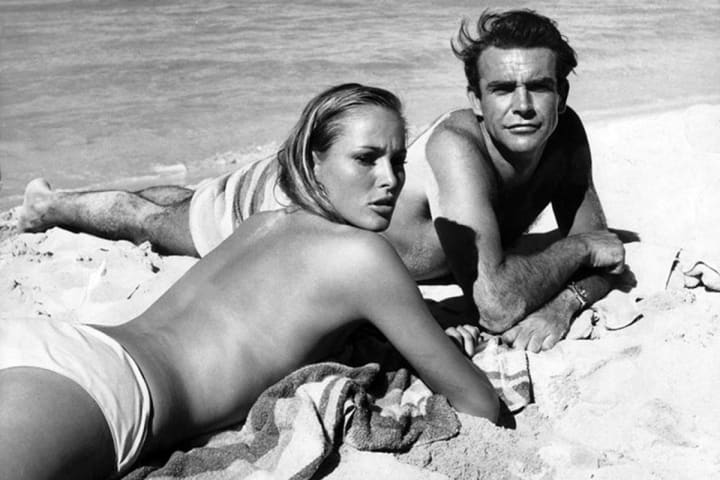Foreign Film History
Foreign film history was largely a voyeuristic experience.

It's getting harder and harder these days to remember that once upon a time there was such a thing as honest-to-goodness foreign films. Back before Black American Express cards and Amazon Prime, before a flight to Europe was less than six hours and when England was still a long boat ride away, there was a sense of illicit adventure in going to those out-of-the-way theaters that specialized in showing films made abroad. The unfamiliar backgrounds and the struggle with the subtitles were all part of the feeling that you were peeking through a keyhole into another world.
Foreign film history had largely been a voyeuristic experience. Most likely it was a boudoir if the film were French or Italian, or a view of somebody's upper lip being tested conspicuously for its stiff British personality. In comparison to the vacuous fluff that Hollywood unreeled endlessly across American screens at the time, people marveled at how sophisticated, how subtly different the foreign movies were from our own rather consumer-driven lives. Only later did it begin to dawn on some of us that this national flavoring was in one sense nothing more than a collection of galloping ineptitudes; that when you got down to the small strokes it was actually through these that national differences were maintained. There was a different ineptitude in the film industry of each country. The Italians, for instance, were lousy at using color, the French were no good at keeping a story straight, the Swedes had no feeling for spectacle, the British had little sense of physical action. All of these things Hollywood managed very well.
Whether it was some sort of compensation for these deficiencies or simply a coincidence, each European industry featured other specialties of its own. No one could touch the British when it came to suspense and sheer storytelling fascination, particularly in the area of mysteries and thrillers. Those were the days when Carol Reed was turning out lulus like Odd Man Out, when Trevor Howard and the unforgettably beautiful young Jean Simmons appeared in the psychological thriller, The Clouded Yellow.
The Italians developed a rough and ready style of realism that used the shabby anti-romantic backdrop of postwar Italian cities, laced with trolley wires overhead and crumbling buildings below, to evoke a strident modern poetry amid the pasta. The French became masters of an understated irony, cynical and tart (no pun intended), built out of scenes, not stories, and great women who could act, like Jeanne Moreau, and some who obviously didn’t have to, like Bardot. In the work of each country there was an honesty and a lack of sentimentality that exposed Hollywood as the mindless dream factory it mostly was.
Then, only a few years after the end of World War II, the sense of Europe as an exotic locale began to fade. Over here, foreign movie houses became not only acceptable but elegant. People started phoning to make sure they didn't arrive in the middle of the picture, and the theaters began serving espresso. That should have tipped us off, if nothing else did, that movie men had begun to discover how much money there was in the international market. American marketing methods were one thing, but when Hollywood taste began to penetrate the content of the pictures, the trouble really began. Slowly but surely the foreign film started to sink into the suburbs of Hollywood.
James Bond

The James Bond series was the first to strongly reflect that West Coast feeling. Perceptive English jewels like Albert Finney's Charlie Bubbles all but vanished; so did the early Italian masterpieces like Paisan or Open City, Bicycle Thief, and the memorable Two Women with Sophia Loren. Truffaut and Antonioni tried to continue their unique directorial talents, but they and men like them became more and more the minority all over Europe, until they faded from the scene.
More importantly, in each case where a distinctive European style faded, it is the drift toward the American style of moviemaking—more color, more extravagance, more sentiment—that had been the mischief-maker.
Consider the Italians; even sadder, consider Mastroianni in particular. Poor Marcello. Whatever his talents may have been, they obviously did not extend to choosing the right vehicles for himself. He was in so many losers, but each one grew out of a sudden Italian ambition to ape the Technicolor romances of American cinema, the exact antithesis of the realism that was the natural Italian style. The result was a series of tasteless wonders like Shoot Loud, Louder, and Kiss The Other Sheik, films which mercifully no one saw and are memorable only for the talent wasted on them. And what about Lollobrigida in Buono Sera, Mrs. Campbell? What is that all about—Italy’s version of Doris Day?
In the work of each country there was an honesty and a lack of sentimentality that exposed Hollywood as the mindless dream factory it mostly was.
The French are no better. It must have been some sort of Gallic cinematic death wish that cast Belmondo (the cynical star of the hard-bitten Breathless) in a bit of romantic meringue like That Man From Rio, which was like Bogart trying to play Nelson Eddy. Or Belmondo in a costume horse epic called Cartouche (Bogart as Errol Flynn). In both cases the flesh was willing but the spirit was ridiculous. Even the tart French elan faded into the Hollywood sunset; By the time Claude Lelouch finished dousing A Man and a Woman with Hollywood sentimentality, the only things truly French about it were Anouk Aimee's bare back (no bra! no bra!) and a general carelessness with the story line. And where was the biting Parisian view of love? Buried under a soundtrack of 600 California violins.
In the case of British films the results of this Americanization have been most damaging of all. Without a language barrier to protect them, the British have been sitting ducks for the worst Hollywood influences. The delicious understatement of the old Alec Guinness gems like The Man in the White Suit or The Lavender Hill Mob have been replaced by so-called mystery-adventure films that are hung up on money and mod, or that try to substitute Technicolor for tension. It ain't funny, McGee, these sagging bits of fluff like Otley, a film of last spring about an amiable London grifter caught up in an espionage murder. In the old days it might have been one of those happily tense little English mysteries that kept the audience sitting right on the edge of its mind, instead of a blast of eye-shattering exaggeration that steals the scene from the actors and is itself stolen right out of the overblown Matt Helm series in which Dean Martin has found himself trapped lately. If the British are going to crib from the American movies, why don’t they at least pick the good ones?
The ultimate result of all this transatlantic blending is the epidemic of current films that have the taste of every nation and the flavor of none—that bastard composite euphemistically known as the “international hit.” Candy is one of the best, or worst, samples of the breed. With a Swedish girl in the lead, supported by hordes of American and British superstars like Ringo Starr, Marlon Brando, and Richard Burton, it proves only that top-heavy ballast is too much for any ship, and it promptly sank with all hands and a large, tasteless gurgle. The moral is really simple, after all. The various European film industries would be better off if they left Hollywood methods to Hollywood—the color, the posh decor, etc.—and stuck to what they know best.
About the Creator
Peter Dill
Ph.D. in Cinema Studies, born in LA moved to New York, will never regret it.






Comments
There are no comments for this story
Be the first to respond and start the conversation.